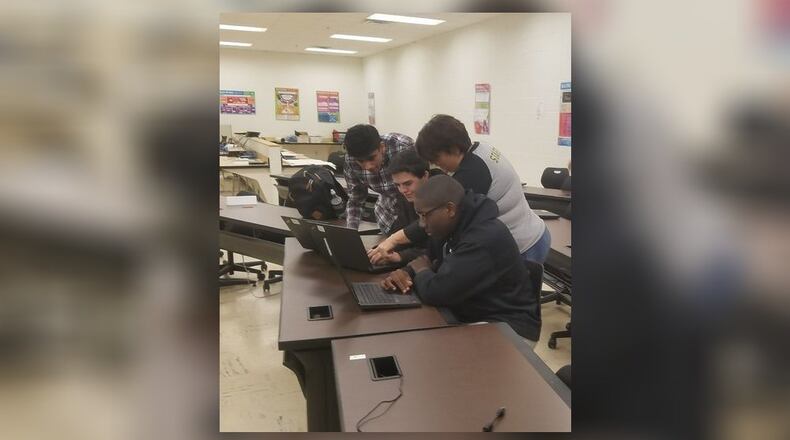Recent cyber attacks on Georgia cities could be a sign that Georgia high school students who are studying cyber security have a bright future.
Atlanta and Loganville are among the latest victims of hacking attacks, and the metro region, with businesses such as Equifax, is a target because it is a capital for financial technology and payments.
The criminal activity is not expected to slow down, and that means well-paying jobs in the cybersecurity field are expected to keep growing.
“The state is making a major investment into information cybersecurity,” said Stanton Gatewood, Chief Information Security Officer for the State of Georgia. “We are building a cybersecurity workforce that will bring us up to speed with what’s going on all over the world.”
Some of Georgia’s education systems are preparing their students for those jobs by forming cybersecurity “pathways.”
Henry County Schools have had a cybersecurity education track for two years and Gwinnett County Schools will have a program with the new Paul Duke STEM High School set to open this fall.
The program was in the works a year earlier at Henry County’s Academy for Advanced Studies, but it didn’t fully take off until 2016, said Melissa Rommelman, an information technology instructor there.
“This current school year the academy will have its first pathway completers as they are taking the third-year course, Advance Cyber Security,” she added. “Students will take the end of pathway assessment in mid-April for the first time, which is an exciting for both student and teacher.” The exam those students will take is for a computer security certification that “is globally recognized and will validate student’s knowledge.”
While the number of engaged students is small, Rommelman said, as awareness grows, demand will follow.
“The original class for [Intro to Computer Science] started with six students in 2016-2017 and 22 students in 2017-2018,” she said. “In the 2018-2019 school year, there will be approximately 13 students in ICS and the academy is projecting to have 24 student complete the Cyber Security pathway.”
As part of the Norcross cluster, the Paul Duke school has already identified students from middle school that have shown interest in cyber security and related fields. They’ve started with the introductory courses and in August, many will be ready for the next stage.
The building is in the late stages of contruction, and the academics will focus on high demand careers with access to both college level coursework and technology-focused experiences. Eligible students will graduate with an associates degree in their chosen field which includes cyber security.
“The students will be in environments where they’ll learn how to respond to security threats,” said Jonathon Weatherington, the Paul Duke principal. “Even if that’s not their chosen field, everyone needs to be aware of these kinds of risks these days. We’re at a point where every employee needs to be aware of risks.”
In a survey by the International City/County Management Association and the University of Maryland, Baltimore County, 25 pecent of local governments reported that their computer systems are attacked as often as once an hour. While many of these strikes are unsuccessful, the number makes the need for increased security apparent.
The 2017 Global Information Workforce Study, based on a survey of 19,641 cyber security professionals in 170 countries, forecasts a cybersecurity workforce gap of 1.8 million by 2022, a 20 percent increase from the same study’s 2015 prediction.
State officials are taking action to change those numbers.
In December of 2013 the U. S. Army Cyber Command announced it is moving to Fort Gordon by 2019. That prompted the state to create a cybersecurity initiative to grow the next generation of cyber security experts.
From that initiative grew the Hull McKnight Georgia Cyber Center for Innovation and Training in Augusta. The $95 million facility, set to open in July, represents the single largest state government investment in a cybersecurity facility in the nation to date. A primary focus is workforce development, to fill the growing shortage of cybersecurity talent in the state and nation.
“There is such a tremendous need for people with these job skills,” said Calvin Rhodes, Chief Information Officer for the State of Georgia and Executive Director of the Georgia Technology Authority. “Today’s threats are more complex and the need is only increasing.”
The center will connect academic programs with innovative startups and established technology companies. It will also serve as an incubator for startup cybersecurity companies and focus on research and development by tapping into the assets of Georgia’s research institutions.
Nearby school systems in Columbia and Richmond counties in partnership with Fort Gordon, Georgia Regents University and Augusta Technical College will roll out cyber security curriculum this fall. Students will gain a background in digital technology that includes protecting networks from outside attacks and how to develop network-level security policies.
With the state’s emphasis on combating cyber crime, both Rhodes and Gatewood are optimistic that it may become a $1 billion industry.
“We’re already looking at next steps and ways to stay cutting edge,” said Gatewood. “This will have advantages for government agencies and the private sector.”
National numbers
In 2013, there were 78,020 ISA workers nationally
By 2016, there were 96,870 ISA workers nationally.
That’s growth of 24 percent.
In 2013, ISA workers nationally averaged $43.85 an hour
By 2016, ISA workers nationally averaged $46.17 an hour
That’s growth of 5.9 percent.
In 2013, ISA workers nationally averaged $91,210 a year
By 2016, ISA workers nationally averaged $96,040 a year
That’s also growth of 5.9 percent.
State numbers
In 2013, there were 2,120 ISA workers
By 2016, there were 2,310 ISA workers
That’s growth of 9 percent.
In 2013, ISA workers here averaged $39.35 an hour
In 2016, ISA workers here averaged $43.18 an hour
That’s growth of 9.7 percent
In 2013, ISA workers here averaged $81,860 a year
By 2016, they averaged $89,820 a year
That’s also a 9.7 percent increase
Metropolitan Atlanta Statistical information
In 2013, there were 1,790 ISA workers here
In 2016, there were 1,860 ISA workers here
That’s growth of 3.9 percent
In 2013, ISA workers in Atlanta averaged $40.35 an hour
In 2016, they averaged $44.65 an hour
That’s growth of 10.7 percent
In 2013, ISA workers in Atlanta averaged $83,930 a year
By 2016, they averaged $92,880 a year
That’s also growth of 10.7 percent.
MORE DETAILS
Cybersecurity and Georgia
The U. S. Army Cyber Command is moving to Fort Gordon by 2019.
The state’s Hull McKnight Georgia Cyber Center for Innovation and Training in Augusta is set to open in July.
Henry County schools have had a cybersecurity education track for two years, while Gwinnett County Schools will have a program starting this fall. Schools near Augusta also are planning programs.
About the Author
Keep Reading
The Latest
Featured


